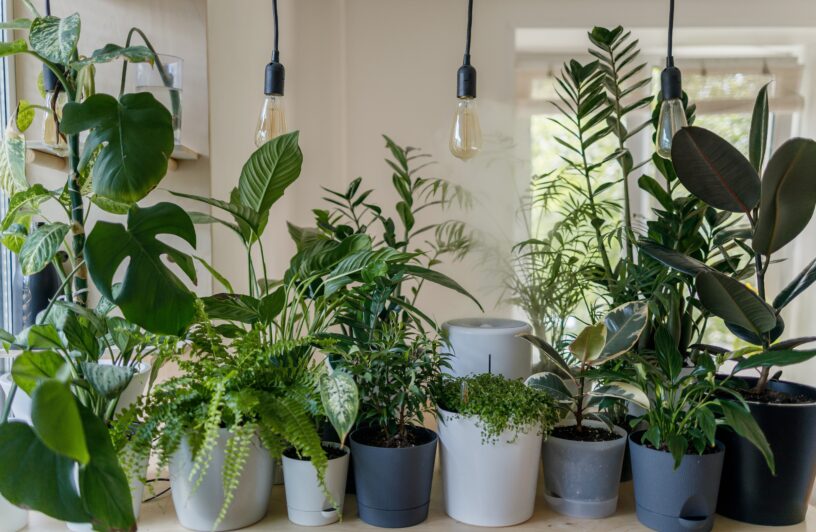After reading the last column on houseplants, it should now be known that low light plants do not mean no light at all. Low light for a houseplants means you can still read a book in that area even if it is not getting bright/direct or indirect sunlight.
Usually, succulents are advertised as easy plants or beginner plants. However, in my experience that is untrue. Tropical plants are more beginner-friendly than succulents for a few reasons. The first one being that they will respond visibly to your care, whereas succulents will not. If you overwater a tropical plant, the leaves will wilt and turn yellow, responding to its roots rotting. If you underwater a tropical plant, its leaves will curl up and the whole plant will wilt. The response to over and underwatering varies from plant to plant. Nevertheless, succulents do not visibly respond to overwatering until it is too late. In my experience with beginning plant care, I have only ever noticed a succulent dying from overwatering when it is already rotting from overwatering. There are no visual cues, like a yellowing leaf or wilting, to show me that I am watering too much. Also, it is difficult to tell when a succulent needs water until it shows very urgent signs of underwatering.
Furthermore, tropical plants are more flexible with their light requirements. Most succulents need bright direct light whereas beginner tropical houseplants can grow in lower or moderate light settings. Placing most succulents in a low or moderate light setting would encourage the succulent to etiolate and deform, which means it is reaching toward the light source.
Generally, tropical houseplants are more adaptable to a variety of environments and are more forgiving of a heavy handed watering or some neglect. With this information in mind, here is a list of beginner-friendly houseplants!
1. Vining Philodendrons
There are two main types of philodendrons: self-heading and vining. Self-heading philodendrons are more arborescent or “tree-like”. This means they have stiff stems which hold them upright; these are less beginner friendly. Vining philodendrons just resemble a vining plant. They can be trained to grow up a trellis, a moss pole or just hanging. Popular and easy-to-care-for varieties of vining philodendron include: Philodendron cordatum ‘Lemon-Lime’, Philodendron brazil and Philodendron cordatum. There are many other types of vining and self-heading philodendron.
Signs of overwatering: Yellowing leaves, wilting leaves.
Signs of underwatering: Rolled up leaves.
Care: Water when the top two inches are dry or the pot feels light. If you prefer to wait until the leaves roll up, that is okay too, just make ABSOLUTELY SURE to water when the leaves roll up.
2. Pothos
Pothos, like philodendron, is another vining plant that does well in low light conditions. There are many types of beautiful pothos with lovely variegation. Variegation is essentially a lack of chlorophyll in a plant’s leaves which appears as differently-coloured areas. The more light a plant gets, the more variegated its leaves will become. Many of the types of pothos differ because of their variegation. Here are some popular favourites. Jade pothos (no variegation), golden pothos, marble queen pothos, pothos n joy and pearls n jade pothos. Pothos are forgiving if you forget a watering or are a bit heavy handed with the water a few times.
Signs of overwatering: yellowing leaves, wilting leaves.
Signs of underwatering: curled up leaved.
Care: Same as philodendron.
3. Spider Plants
Spider plants are gorgeous and popular houseplants. They can flower in the right conditions and have little baby spider plants called “pups”. If you remove these from the mother plant, you get a whole new spider plant! You can also leave them on. There are many different varieties of spider plants, a popular one at the moment being the “ocean” variety with white variegation lining the edges of the leaves.
Signs of overwatering: Browning or blackened leaves, wilting.
Signs of underwatering: Discoloration at tips of leaves, lightened color on leaves.
Care: Water when the green in the leaves lighten or the top two inches of the soil are dry.
4. Peace Lily
Peace lilies are one of the sturdiest houseplants out there, next to pothos and snake plants. My parents received a peace lily as a housewarming gift after their marriage 32 years ago and it is still alive and thriving (it is HUGE). These plants are the most forgiving of overwatering and tend to like consistently moist soil. So, if you tend to overwater a bit, this is THE plant for you. It can thrive in low light environments and is very rewarding with its growth and blooms to a variety of environments.
Signs of overwatering: Wilting, yellowing leaves.
Signs of underwatering: Wilting, browning tips.
(The signs of over and underwatering are similar, so check the soil. If it is wet to the touch, the plant is overwatered. If it is very dry, the plant is underwatered.)
Care: Water when top two inches of soil are dry, or when plant is wilting and soil is dry.
5. Snake Plant
Snake plants are slow growers and don’t mind being left alone. This is one of the plants that are advertised as “thriving on neglect” but that doesn’t tell you how to care for them. These plants are very forgiving if you tend to forget to water your plants. They are a type of succulent but much more responsive than other types of succulents. There are many beautiful varieties. My favourite is the moonshine variety. The new leaves are minty green and darken with maturity.
Signs of overwatering: Mushy leaves.
Signs of underwatering: Wrinkled leaves, drooping leaves.
6. Monstera
Monsteras are one of the most popular and sought-after houseplants as of late. Avid houseplant collectors pay hundreds of dollars or more for the rarer varieties with unique variegation. However, a good old green monstera is still gorgeous to me. There are three very popular (and don’t worry, still affordable) types: Monstera deliciosa, Monstera adansonii (both varieties are nicknamed “the Swiss cheese plant”) and the “mini monstera” Rhaphidophora tetrasperma. All of these varieties have more fenestrations as the leaves mature, which are types of hole patterns that indicate maturity. My favorite type is the mini monstera.
Signs of overwatering: Yellowing leaves, wilting.
Signs of underwatering: Curling leaves, wilting.
Now, you’ll notice that some signs of overwatering and underwatering overlap. The key to checking the water in your plant is the soil. If the soil is dry and the plant shows sign of underwatering, give your plant a good watering and let it drain. It should perk up in a few house. If the soil is wet to the touch and the plant shows signs of overwatering, chances are the roots are rotting and the plant is suffering from overwatering.
In the next column, we will talk more about overwatering and soil, and how overwatering really has nothing to do with the amount of water you give a plant. (Surprise!)





Leave a Reply